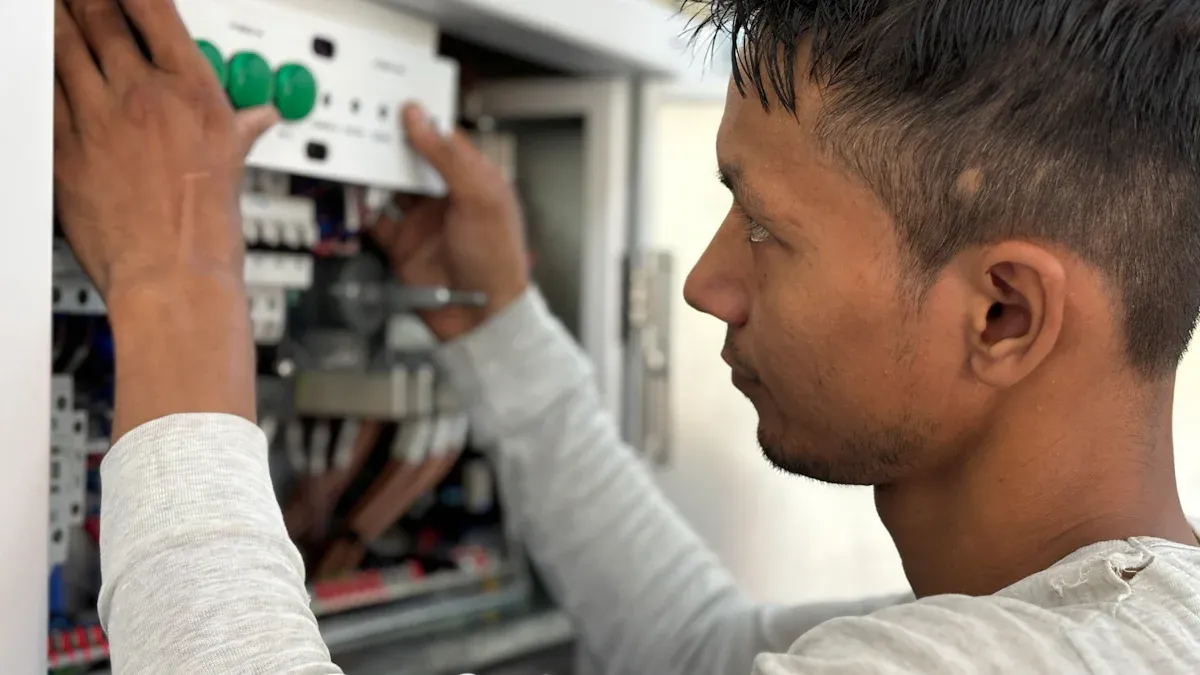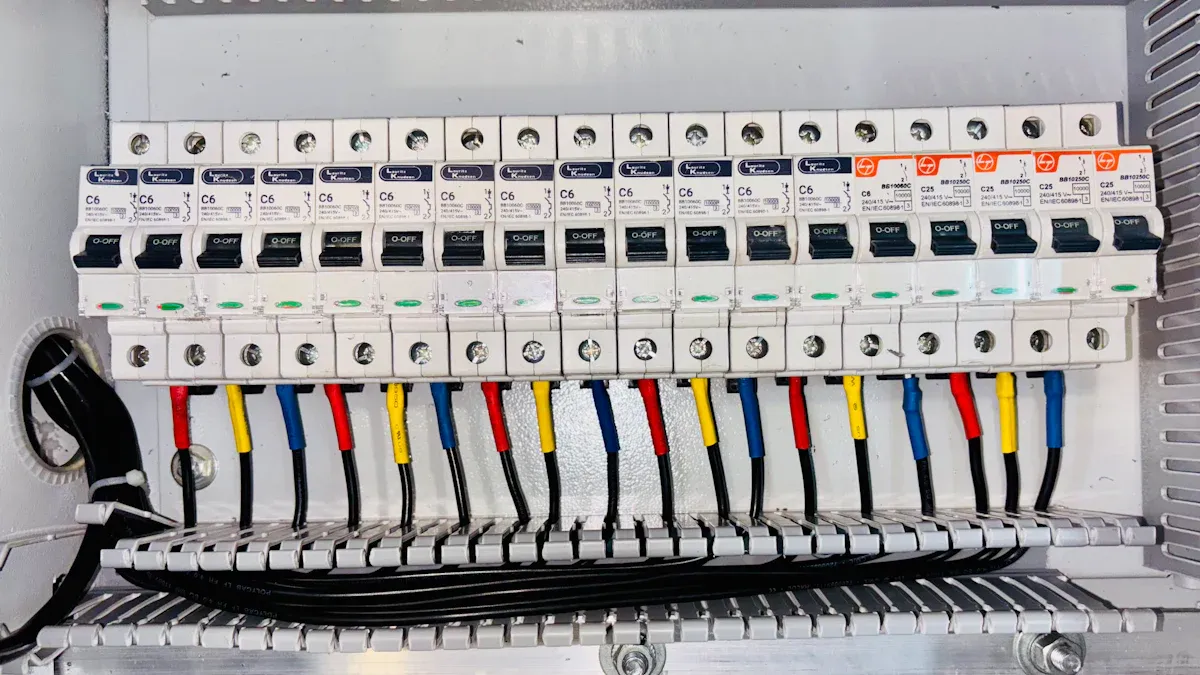Replacing a 15 amp breaker with a 20 amp breaker is unsafe. Circuit breakers stop overloads by cutting power when current gets too high. If you replace circuit breaker types incorrectly, it slows this process, causing overheating risks. Electrical rules need the right wire size for each breaker to keep things safe.
Key Takeaways
-
Switching a 15 amp breaker to a 20 amp one is dangerous. It might cause wires to overheat and start fires.
-
Always look at the wire size before replacing a breaker. A 20 amp breaker needs thicker 12-gauge wires to work safely.
-
Ask a trained electrician for help with breaker changes. They make sure your system is safe and works correctly.
Why You Shouldn’t Replace a Circuit Breaker Without Proper Assessment
The role of circuit breakers in electrical safety
Circuit breakers keep your home safe from electrical problems. They work like switches that stop electricity when something goes wrong, like an overload or short circuit. This helps prevent fires and electric shocks. For example, AFCI breakers stop dangerous sparks, and GFCI breakers protect in wet areas. Circuit breakers only shut off the problem area, so the rest of your home stays powered. Taking care of these devices is important to keep your home’s wiring safe.
Importance of matching breaker amperage to wire gauge
It’s very important to match breaker size to wire size. Each wire can only handle a certain amount of electricity before it overheats. For example, a 15-amp breaker needs 14-gauge wire, and a 20-amp breaker needs 12-gauge wire. Using a breaker that’s too strong for the wire can cause overheating and fires. The table below shows the right wire size for each breaker:
|
Wire Gauge |
Maximum Amperage |
|---|---|
|
14 AWG |
15 A |
|
12 AWG |
20 A |
|
10 AWG |
30 A |
Always check the wire size before changing a breaker to make sure it’s safe.
Risks of mismatched breakers and wiring
Changing a 15-amp breaker to a 20-amp breaker without checking is dangerous. Bigger breakers let more electricity flow, which can overheat wires and cause fires. Experts say mismatched breakers and wires are very risky and can lead to disasters.
The data shows that faulty circuit breakers of inferior models on the market cause approximately 2800 fires, 13 deaths, and $40 million in losses annually. These dangers and losses also illustrate why caution should be exercised and licensed electricians consulted before making changes to the electrical system.
Risks of Replacing a 15 Amp Breaker with a 20 Amp Breaker

Overheating and fire dangers
Switching a 15 amp breaker to a 20 amp one can overheat wires. Wires are made to carry only certain amounts of electricity. A stronger breaker lets too much electricity flow, which overheats the wires. This heat can melt the wire covering and start fires.
Overheating is a major cause of house fires. Experts say overloaded circuits often lead to electrical fires. Changing breakers without checking the wiring can make your home unsafe. Circuit breakers are not just switches; they protect your home from danger.
Harm to appliances and wiring
Using a 20 amp breaker on a 15 amp circuit can damage appliances. Breakers stop power during overloads to protect devices. A stronger breaker might not trip fast enough, harming electronics. For example, a power surge could ruin your TV or fridge.
Wires can also get damaged. Overheated wires lose their insulation, exposing the metal inside. This can cause sparks or short circuits, which may start fires. High-power devices like microwaves need their own circuits. Without proper breakers, these devices can fail or catch fire.
Breaking codes and legal issues
Replacing a 15 amp breaker with a 20 amp one without fixing the wiring breaks safety rules. The National Electrical Code (NEC) requires breakers to match wire sizes. Ignoring these rules can lead to big problems.
Breaking electrical codes can cancel your home insurance. If a fire happens and the wrong breaker is found, insurance might not pay. You could also face fines or legal trouble for ignoring safety standards. Always ask a licensed electrician before changing your electrical system.
Technical Requirements for Safely Upgrading a Circuit Breaker

Wire gauge compatibility (12-gauge wire for 20 amps)
If you want to upgrade to a 20-amp breaker, check the wires first. A 20-amp breaker needs 12-gauge wire to handle the extra power safely. Using thinner wires, like 14-gauge, can cause overheating and fires. The National Electrical Code (NEC) says wire size and breaker size must match to avoid danger.
Here’s a table showing the correct wire sizes for breakers:
|
Wire Gauge |
Required Breaker Size |
|---|---|
|
12-gauge |
20-amp |
|
14-gauge |
15-amp |
Before replacing a breaker, look at your home’s wiring. If the wires aren’t 12-gauge, you’ll need to upgrade them first. This keeps your electrical system safe and follows the rules.
Evaluating circuit load capacity
Upgrading a breaker isn’t just about wire size. You also need to check if the circuit can handle more power. This helps prevent overheating or other problems.
One way to check is by using temperature sensors. These sensors find overheating in wires or devices. For example:
-
A 21°C rise above normal means there might be a problem.
-
A 40°C rise is very serious and needs fixing fast.
Other tools, like power loggers, can show how much electricity is being used. Here’s a table of helpful tools:
|
Technique |
Description |
|---|---|
|
Power Loggers |
Tracks electricity use and shows detailed reports. |
|
Thermal Monitoring |
Uses sensors to find overheating in wires or devices. |
|
Electrical Signature |
Checks how devices use electricity to see if they’re working well. |
These tools help make sure your circuit can handle more power safely. Checking this is important to avoid problems like overheating.
Consulting a licensed electrician for upgrades
Upgrading a breaker isn’t something you should do yourself. A licensed electrician can do it safely and correctly. They check your system to make sure it works with the new breaker. They also follow local safety rules.
Electricians know how to spot problems, like old wires or circuits that can’t handle more power. They make sure your home stays safe and meets all the rules.
If you try to replace a breaker yourself, you could make mistakes. This might damage your equipment or fail inspections. Hiring an electrician protects your home and ensures everything is done right.
Following Electrical Codes and Standards
What the NEC (National Electrical Code) Says
The NEC gives rules for safe electrical setups in the U.S. These rules help your home’s electrical system work safely. When changing breakers or upgrading, you must follow these rules. For example: breaker size must match wire size to stop overheating. The NEC also requires special breakers, like AFCI or GFCI, in certain areas to prevent fires and shocks.
Updating your system to meet NEC rules avoids safety problems. Regular upgrades also keep your home ready for modern standards. This is important if you want to sell your house. Following these rules keeps your home safe and protects your family.
Why You Need a Professional
You should hire an electrician for breaker upgrades. Experts make sure your system is safe and works well. They check for problems like old wires or circuits that can’t handle more power. Proper installation lowers the chance of fires by ensuring wires are connected securely.
Electricians have tools and skills for tricky jobs. They can check if your circuit can handle a stronger breaker. Their knowledge makes sure upgrades are safe and done right. This gives you peace of mind.
What Happens If You Ignore Rules
Not following electrical codes can cause big problems. It raises the risk of fires, shocks, and broken appliances. It might also cancel your home insurance. If inspectors find code mistakes after a fire, insurance may not pay for damages.
Breaking rules can also lead to fines or legal trouble. Local governments enforce NEC rules, and ignoring them can cost you money. To avoid these issues, always hire an electrician and follow the rules when upgrading your electrical system.
Switching a 15 amp breaker to a 20 amp one needs careful checks. You must check the wires and power load for safety. Using a 20 amp breaker on 14-gauge wire can overheat and cause fires. Always ask a licensed electrician to safely replace breakers and follow safety codes.
FAQ
What happens if you use a 20 amp breaker on 14-gauge wire?
Using a 20 amp breaker with 14-gauge wire is unsafe. The wire can’t handle the extra electricity, which causes overheating. This raises the chance of fires and damages your electrical system.
What tools can help you check circuit load capacity?
Tools like power loggers, thermal sensors, and analyzers can help. They find overheating, measure electricity use, and check circuit safety.
Tip: Always ask a licensed electrician to explain tool results.
What should you do before upgrading a breaker?
Check the wire size and how much power the circuit uses. Make sure the wires match the breaker’s strength. If you’re unsure, get a licensed electrician to inspect your system.
The following information may be of interest to you
How many watts can a 20 ampere circuit breaker handle
How to choose the appropriate size of circuit breaker
What Causes Circuit Breaker Overheating and How to Prevent It



